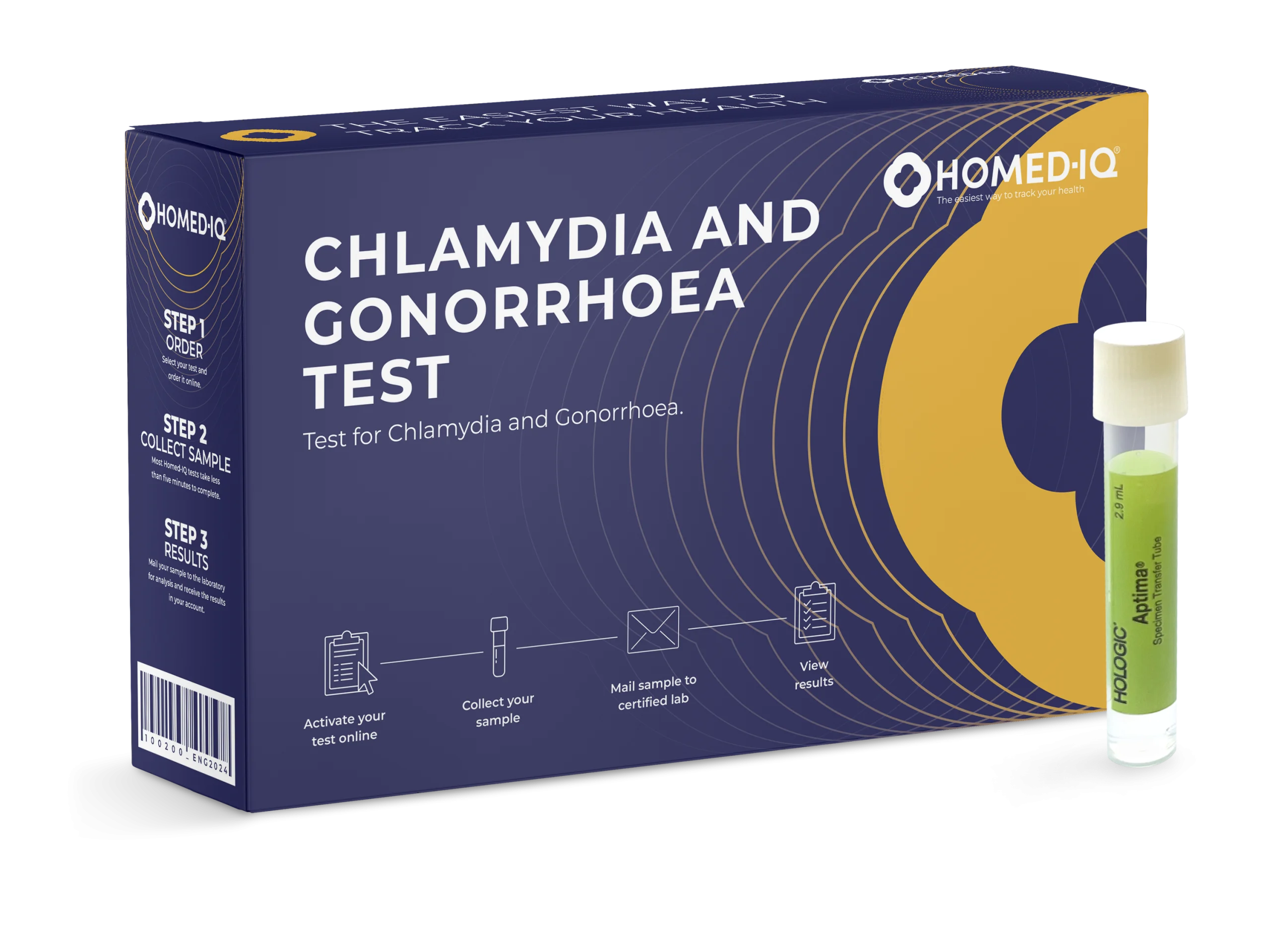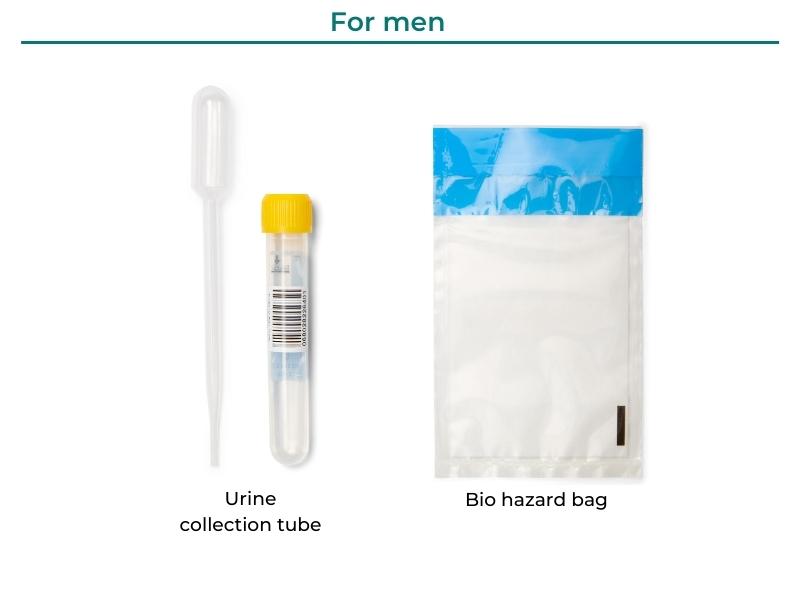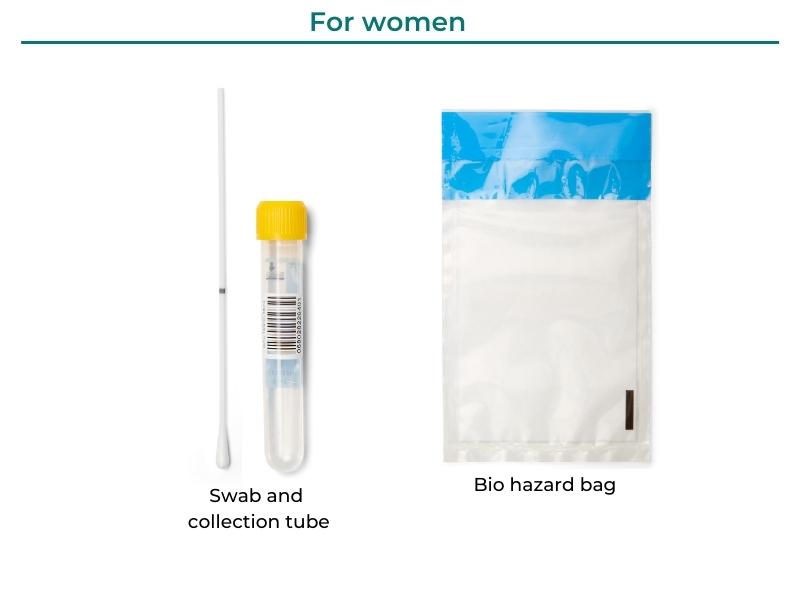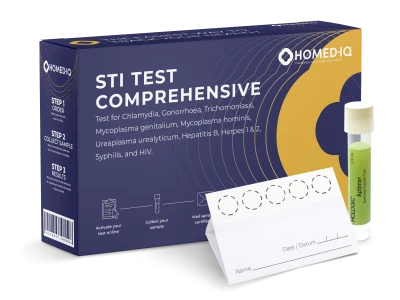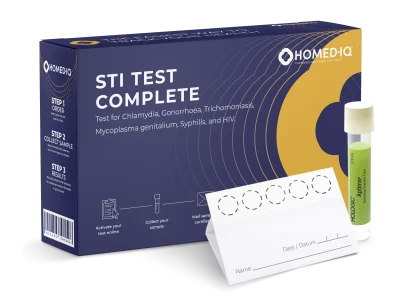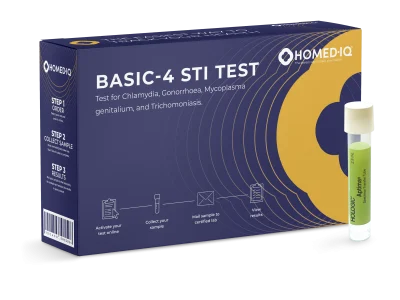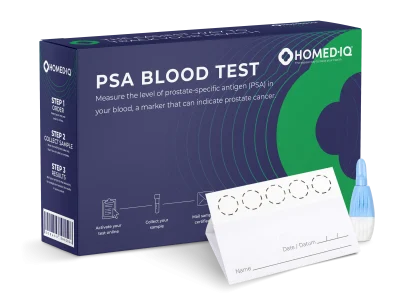

Chlamydia and Gonorrhoea Test
2 in 1 STI Test
Original price was: €49,00.€39,00Current price is: €39,00.
Free Shipping to
Chlamydia and gonorrhoea are two of the most common STIs, but often have no symptoms. Whether you have recently had unprotected sex or have a new sexual partner, getting tested regularly for chlamydia and gonorrhoea is a good idea. This simple test involves either a swab or urine sample and can be taken from home in minutes.
Test mode:
For men: a urine test
For women: a vaginal swab test
For infections of the throat or anus: a swab test
Window Period:
The window period is the time between when you were infected with an STI and when it is detectable with a test. See the ‘About this test’ section or the blog ‘When can you be tested for STIs?‘ for more information about when you can reliably test for each STI.
What do we test for?
About Chlamydia
Chlamydia is a sexually transmitted infection caused by the bacteria Chlamydia trachomatis. The bacteria can cause an infection of the urethra, cervix, rectum, or throat. Chlamydia is transmitted through vaginal, anal, and oral sex, or contact with infected genital fluids. The infection can spread to the epididymis in men and to the uterus or fallopian tubes in women. Left untreated, a chlamydia infection increases the risk of infertility or an ectopic pregnancy. Giving birth with chlamydia can also lead to eye and respiratory infections in the baby. Chlamydia is a very common STI and is usually treatable with antibiotics.
About Gonorrhoea
Gonorrhoea is a highly contagious sexually transmitted infection caused by the bacteria Neisseria gonorrhoeae. Not everyone with gonorrhoea develops symptoms, making early detection difficult. If left untreated, gonorrhoea can cause further health problems. In women, untreated gonorrhoea can cause pelvic inflammatory disease or infertility. In pregnant women, inflammation of the uterus, preterm birth, and ectopic pregnancy can occur. Pregnant women with gonorrhoea can also infect their baby during childbirth. This can lead to eye inflammation and blindness in the baby. In men, untreated gonorrhoea can cause inflammation of the epididymis or prostate. In rare cases, gonorrhoea can enter the bloodstream and cause infections in other parts of the body. This can lead to joint inflammation, blood poisoning or meningitis. Gonorrhoea is treatable with antibiotics.
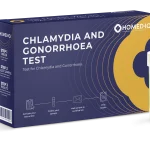
Original price was: €49,00.€39,00Current price is: €39,00.
Free Shipping to
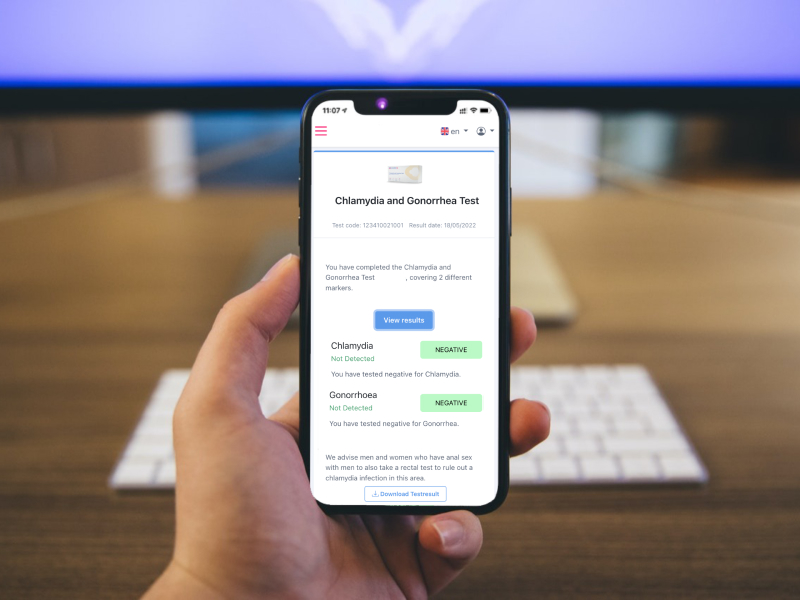
What does the result of this test mean?
Anyone who orders a home test from us will receive a complete laboratory report.
What does a negative test result mean?
A negative test result means that no chlamydia or gonorrhoea were found in the test material you supplied and that no STI treatment is required.
What does a positive test result mean?
A positive test result means that one or more STIs has been found and that treatment is needed. For your own health and to prevent the spread of STIs, it is important that you receive treatment if you test positive.
In the case of a positive test result, you can take the test results to your own doctor for treatment. You should also warn all your sexual partners to further prevent the spread of STIs. They can then have themselves tested and, if necessary, be treated.
How results are shared
We understand that medical test results can be confusing and difficult to interpret. That’s why at Homed-IQ we make it as easy as possible for you to understand your test result.
In your personal online dashboard you can view your laboratory report as well as a clear and simple explanation of your results. We provide insight into whether you have tested negative or positive for each individual STI.
How soon will I receive my test results?
You will receive the test result very quickly, often within one to three working days after your sample has arrived at our certified laboratory.
What is a Chlamydia and Gonorrhoea Test?
This test is used to show whether you are infected with the chlamydia or gonorrhoea bacteria. The test consists of materials for taking a sample from either the vagina, penis, throat, or anus. You will receive extensive instructions with your self-test. After collection you can send in your sample and it will be examined by a certified laboratory. You will receive the results within a few days. It couldn’t be easier!
What’s in the test kit?
- Instruction manual
- A pipette and test tube for a urine test, or a cotton swab with collection tube for a vaginal, throat, or anal swab
- A protective transport bag
- A return envelope
When can you test for each STI?
The window period is the time between when you were infected with an STI and when it is detectable with a test. Every STI has its own window period. If you test for an STI before the window period has passed, you may test negative even if you are infected. See below for more information about the specific window period per STI and determine when you can reliably administer this test.
What is the window period for chlamydia and gonorrhoea?
Chlamydia: After 14 days
Gonorrhoea: After 14 days
Source: Nederlands Huisarten Genootschap
Chlamydia
- (Burning) pain while urinating
- Discharge from the penis
- Pain or swelling in the testicles
- Pain during sex
Gonorrhoea
- Pain or swelling in one of the testicles
- Pus-like discharge from the penis
- Burning pain while urinating
- Pain during sex
- In case of anal infection: irritation, itching, mucous discharge, diarrhea and the urge to (but inability to) pass stool
- In case of infection of the throat: sore throat, pain when swallowing, swollen glands in the neck
Chlamydia
- Pain while urinating
- Abdominal pain in the lower abdomen, sometimes with fever
- Increase in vaginal discharge
- Pain during intercourse
- Bleeding after intercourse
- Bleeding between periods
Gonorrhoea
- Pain when urinating
- Vaginal discharge (green/yellow)
- Pain in the lower abdomen, sometimes with fever
- Pain during intercourse
- Bleeding after intercourse
- Bleeding between periods
- In case of anal infection: irritation, itching, mucous discharge, diarrhea and the urge to (but inability to) pass stool
- In case of infection of the throat: sore throat, pain when swallowing, swollen glands in the neck
Introduction
Sexually Transmitted Infections (STIs) are infections that are transmitted through sexual contact. STIs can be transmitted through contact with the penis, vagina, anus, and sometimes also with your mouth or fingers. Many STIs cause little or no symptoms. However, STIs are not harmless, and an untreated infection can cause uncomfortable symptoms or serious damage to the body if left untreated. That is why getting tested regularly is important, both in order to prevent the infection from spreading to others and to ensure infections are treated promptly.
Chlamydia
Chlamydia is a sexually transmitted infection caused by the bacteria Chlamydia trachomatis. This bacteria can cause an infection of the urethra, cervix, rectum or throat. Chlamydia is transmitted through vaginal, anal, and oral sex or contact with infected genital fluids. Left untreated, the infection can spread to the epididymis in men, and to the uterus or fallopian tubes in women. This increases the risk of infertility or an ectopic pregnancy. A chlamydia infection during childbirth can lead to eye or respiratory infections in the baby. Chlamydia is a very common STI and is treatable with antibiotics.
Gonorrhoea
Gonorrhoea is a highly contagious sexually transmitted infection caused by the bacteria Neisseria gonorrhoeae. Not everyone with gonorrhoea develops symptoms, making early detection difficult. If left untreated, gonorrhoea can cause further health problems. In women, untreated gonorrhoea can cause pelvic inflammatory disease or infertility. In pregnant women, inflammation of the uterus, preterm birth, and ectopic pregnancy can occur. Pregnant women with gonorrhoea can also infect their baby during childbirth. This can lead to eye inflammation and blindness in the baby. In men, untreated gonorrhoea can cause inflammation of the epididymis or prostate. In rare cases, gonorrhoea can enter the bloodstream and cause infections in other parts of the body. This can lead to joint inflammation, blood poisoning, or meningitis. Gonorrhoea is treatable with antibiotics.
Frequently asked questions
Is this test really anonymous?
How accurate is this STI test?
What are the advantages of this test?
Will my health insurer reimburse this test?
Is this STI home test an alternative to a doctor's examination?
Why should I choose a laboratory STI test and not a rapid test?
How do I get treatment if I test positive?
Why do I need to activate my test kit?
Who is this Chlamydia and Gonorrhoea test suited for?
For whom is the Chlamydia & Gonorrhea test not suitable?
What test do you take to check for chlamydia/gonorrhea?
Which Chlamydia & Gonorrhea test from Homed-IQ should I order?
How do you take a Homed-IQ Chlamydia & Gonorrhea test?
- The Chlamydia & Gonorrhea test for men is a urine test
- The Chlamydia & Gonorrhea test for women is a vaginal swab
- The anal or oral test is a swab test
When can you get tested for gonorrhea?
Can gonorrhea be cured?
What happens if you don't treat gonorrhea?
Can gonorrhea go away on its own?
How quickly do symptoms of chlamydia appear?
Can chlamydia be cured?
Is chlamydia always contagious?
What happens if you don't treat chlamydia?
I have tested positive for an STI. How do I warn my partner?
- Telling them yourself via a phone, email, or in-person conversation
- Anonymously warn them via partnerwaarschuwing.nl (in the Netherlands) or wir-ruhr.de (in Germany). Using these services you can tell someone to get tested without making your identity known.
- Ask your GP or the nurse at an STI clinic to let people you have had sex with know that you tested positive for an STI
